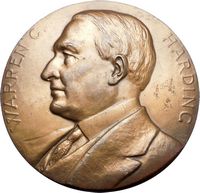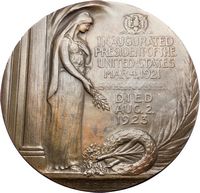U.S. MintMedal of
PresidentWarren G. Harding
75mm (3") (230.8 grams)
Designedby George T. Morgan
Reference: Mint List # 128
WARREN G. HARDING, Bust of Warren G. Harding left, wearing suit and tie.
Liberty standing right, holding olive branch with left hand over heart and veiled, Presidential seal above inscription, INAUGURATED PRESIDENT OF THE UNITED STATES MAR. 4.1921 DIED AUG. 2. 1923, wreath with branch within, pattern design below. You are bidding on the exact item pictured, provided with a Certificate of Authenticity and Lifetime Guarantee of Authenticity.  Warren Gamaliel Harding (November 2, 1865– August 2, 1923) was the29thPresident of the United States (1921–23), aRepublican from Ohio who served in theOhio Senate and then in theUnited States Senate, where he played a minor role. Warren Gamaliel Harding (November 2, 1865– August 2, 1923) was the29thPresident of the United States (1921–23), aRepublican from Ohio who served in theOhio Senate and then in theUnited States Senate, where he played a minor role.
With theRepublican Party convention near deadlock, Harding was chosen as an inoffensive compromise candidate in the1920 election. He brought leading advertising experts on board, especiallyAlbert Lasker, to publicize his presidential appearance and conservative promises. He promised America a "return to normalcy" after World War I, with an end to violence and radicalism, a strong economy, and independence from European intrigues. "Americas present need is not heroics, but healing; not nostrums, but normalcy; not revolution, but restoration; not agitation, but adjustment; not surgery, but serenity; not the dramatic, but the dispassionate;... not submergence in inter-nationality, but sustainment in triumphant nationality." Harding represented the conservative wing of his party in opposition to progressive followers of the lateTheodore Roosevelt (who died in 1919) and SenatorRobert M. La Follette, Sr.. He defeatedDemocrat and fellow Ohio newspaper publisherJames M. Cox with the largest popular vote landslide (60% to 34%) in presidential history. Hardings cabinet includedAndrew Mellon at theTreasury,Herbert Hoover atCommerce, andCharles Evans Hughes at theState Department. He rewarded friends and contributors, known as the "Ohio Gang", with powerful government positions. Multiple cases of corruption were exposed during his presidency and after his death, including the notoriousTeapot Dome scandal, regarded in pre-Watergate times as the "greatest and most sensational scandal in the history of American politics". Domestically, Harding signed the firstfederal child welfare program, and dealt with striking mining and railroad workers in part by supporting an 8-hour work day. He created theBureau of the Budget to prepare the firstUnited States federal budget. Harding advocated an anti-lynching bill to curb violence against African Americans, but it failed to pass Congress. In foreign affairs, Harding spurned theLeague of Nations and negotiated peace treaties with Germany and Austria. His greatest foreign policy achievement came in theWashington Naval Conference of 1921–22, in which the worlds major naval powers agreed on a naval limitations program that held sway for a decade. In August 1923, Harding suddenly collapsed and died in California. His administrations many scandals have earned Harding abottom-tier ranking from historians, but in recent years there has been some recognition of his fiscal responsibility and endorsement of African-American civil rights. Harding has been viewed as a more modern politician who embraced technology and was sensitive to the plights of minorities, women, and labor. |






 Warren Gamaliel Harding (November 2, 1865– August 2, 1923) was the29thPresident of the United States (1921–23), aRepublican from Ohio who served in theOhio Senate and then in theUnited States Senate, where he played a minor role.
Warren Gamaliel Harding (November 2, 1865– August 2, 1923) was the29thPresident of the United States (1921–23), aRepublican from Ohio who served in theOhio Senate and then in theUnited States Senate, where he played a minor role.
